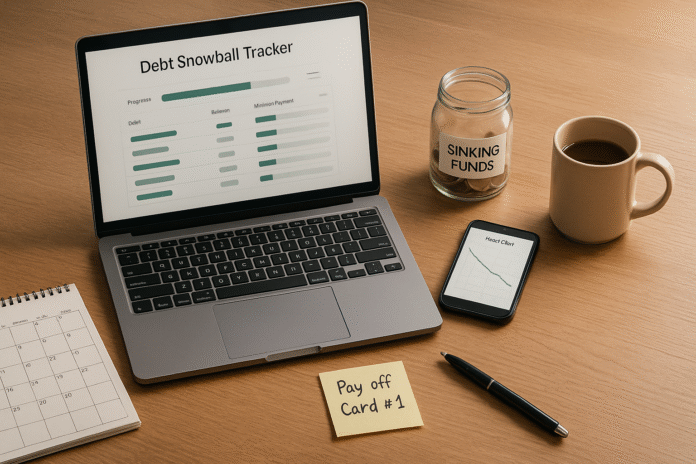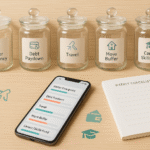If your goal is to become debt-free (and stay that way), the debt snowball approach gives you a clear, motivating path: list debts from smallest balance to largest, make minimum payments on all, then attack the smallest with every extra dollar until it’s gone—rolling that freed-up payment into the next debt like a growing snowball. This guide shows you five practical tools that make the method easier, faster, and far more sustainable. You’ll get simple, beginner-friendly steps, metrics to track, troubleshooting tips, and a four-week starter plan built for real life.
This article is educational and not personalized financial advice. Debt and credit rules vary by country and lender. Consider consulting a qualified professional for guidance tailored to your situation.
Key takeaways
- Build momentum, not just math. Tools that show quick wins and a clear payoff date make the debt snowball stick.
- Automate the boring parts. Minimums, transfers, and reminders should run on autopilot to protect your streak.
- Make your budget zero-based. Give every dollar a job so your snowball payment actually happens.
- Track what matters. Watch a few simple KPIs: on-time payment streak, principal paid this month, utilization, and debt-free date.
- Respect safety rules. Keep minimum payments current, verify prepayment penalties where applicable, and preserve benefits on certain loans.
Tool #1: A dedicated snowball tracker (web or mobile)
What it is & why it helps
A snowball tracker centralizes your debts, orders them from smallest to largest balance, calculates your debt-free date, and produces a month-by-month plan. Seeing the next target, the new payment after each payoff, and the total interest you’ll avoid builds motivation and reduces decision fatigue.
Requirements & low-cost alternatives
- What you need: A device with internet access, basic account info (creditors, balances, minimums, due dates), and your monthly “extra” amount.
- Costs: Free to low monthly cost depending on features.
- Low-cost alternative: A simple printable or spreadsheet with columns for balance, minimum payment, due date, and a checkbox to mark each month’s progress.
Step-by-step for beginners
- List debts (exclude your primary mortgage): creditor, balance, interest rate, minimum, due date.
- Sort by balance from smallest to largest (ignore interest rate for snowball ordering).
- Set a fixed extra amount you can apply beyond minimums each month.
- Generate your schedule. Your tool will show a payoff order, a monthly plan, and a projected debt-free date.
- Turn on alerts for due dates and milestones (e.g., “Debt #1 paid off!”).
- Re-forecast monthly after each payoff or any income/expense change.
Beginner modifications & progressions
- Simplify: If you feel overwhelmed, start with just the first three debts and add the rest later.
- Advance: Add sinking funds and cash-flow forecasting (Tool #5) so your plan survives irregular expenses.
Recommended frequency & metrics
- Weekly: Check off payments, note current balances.
- Monthly: Recalculate your debt-free date and interest saved.
- KPIs: On-time payment streak; number of accounts closed; principal reduction this month; updated debt-free date.
Safety, caveats & mistakes to avoid
- Minimums first. Never starve minimum payments on any account.
- Mind special loans. Some loans can have prepayment penalties or unique rules; verify before making large extra payments.
- Don’t rely on memory. Use alerts so you never miss a due date.
Mini-plan (example)
- Step 1: Enter five debts, set extra payment at 15% of take-home pay.
- Step 2: Turn on reminders: 3 days before and on due date.
- Step 3: After closing the first account, increase your automatic snowball transfer by that minimum payment amount.
Tool #2: A zero-based budget (app or spreadsheet)
What it is & why it helps
A zero-based budget assigns every dollar of income a job—bills, savings, and debt—so your snowball has a permanent “slot” in the plan. It prevents money from drifting into impulse categories and connects your day-to-day spending to your debt-free date.
Requirements & low-cost alternatives
- What you need: Monthly net income, typical spending categories, and a worksheet or budgeting app.
- Costs: Free to modest subscription.
- Low-cost alternative: A one-page spreadsheet with income at the top and categories underneath that sum to zero.
Step-by-step for beginners
- Start at zero. Write down net income for the coming month.
- Fund essentials first (housing, utilities, groceries, transport).
- Set your snowball amount as a fixed “bill.” Treat it as non-negotiable.
- Add sinking funds for near-term expenses (see Tool #5).
- Divide the remainder among discretionary categories.
- Reconcile weekly: Compare plan vs. actual and adjust the rest of the month.
Beginner modifications & progressions
- Simplify: Begin with 8–10 categories, not 40.
- Advance: Add envelope rules (digital or physical) and category-level spending alerts.
Recommended frequency & metrics
- Weekly: Reconcile transactions and move money between categories as needed.
- Monthly: Tweak targets based on actuals.
- KPIs: Budget adherence rate (actual vs. planned), dollars protected for the snowball, variance in top three categories.
Safety, caveats & mistakes to avoid
- Over-complication. If the system takes more than 20 minutes a week, you won’t maintain it.
- Rigid categories. Use a “true-up” rule: move funds among categories without guilt when reality changes.
- Ignoring cash-flow timing. Tie your budget to pay dates (Tool #5) so funds are available when bills hit.
Mini-plan (example)
- Step 1: Allocate a fixed snowball line of $250.
- Step 2: Create “Irregular Bills” and “Car Repair” sinking funds at $50 each.
- Step 3: Review every Sunday; roll unspent dining money into the snowball.
Tool #3: Automation stack (autopay, bill-pay, and reminders)
What it is & why it helps
Automation protects your plan from human forgetfulness. Minimums get paid on time, your snowball amount moves automatically to the current target, and reminders catch anything unusual. The fewer manual steps, the fewer slip-ups—and the more consistent your progress.
Requirements & low-cost alternatives
- What you need: Online banking access, creditor account numbers, and a calendar or reminder app.
- Costs: Usually free through your bank and apps.
- Low-cost alternative: Calendar reminders plus standing bank transfers.
Step-by-step for beginners
- Set autopay minimums on every debt from your checking account.
- Create a separate auto-transfer on payday for your snowball amount into a “debt payoff” sub-account.
- Set a bill-pay rule that pushes the snowball from that sub-account to the current target debt the day after payday.
- Add reminders two to three days before each due date and on the day itself.
- Monitor confirmation messages for any failed or returned payments.
Beginner modifications & progressions
- Simplify: If cash flow is tight, schedule payments for two days after income arrives to reduce risk of overdrafts.
- Advance: Layer in account alerts (low balance, large charge, payment posted) and build a one-month buffer.
Recommended frequency & metrics
- Weekly (5 minutes): Scan transactions for errors.
- Monthly: Confirm all autopays posted; audit failed payments.
- KPIs: On-time payment streak, number of manual interventions, NSF/overdraft incidents (target: zero).
Safety, caveats & mistakes to avoid
- Cash-flow mismatches. If autopay hits before your paycheck clears, you can trigger fees. Align due dates with pay days where possible.
- Set-and-forget risk. Automation is a tool, not a substitute for awareness; review statements for fraud and fee changes.
- Special cases. Some loans can have prepayment penalties or unique payoff posting rules—verify before sending large extra payments.
Mini-plan (example)
- Step 1: Autopay all minimums for the day after payday.
- Step 2: Schedule a same-day transfer of your snowball amount to a sub-account.
- Step 3: Bill-pay the target debt from the sub-account the next morning.
Tool #4: A payoff calculator & scenario planner (spreadsheet or web)
What it is & why it helps
A payoff calculator shows the month-by-month path to zero, your exact debt-free date, and how rolling payments accelerate progress. A robust spreadsheet lets you test “what-ifs” (extra $50/month, biweekly payments, a bonus, or switching to the avalanche method temporarily if interest rates spike).
Requirements & low-cost alternatives
- What you need: Balances, APRs, minimums, due dates, and your snowball amount.
- Costs: Many calculators are free; spreadsheets cost nothing to set up.
- Low-cost alternative: A basic amortization table you build once and update monthly.
Step-by-step for beginners
- Input all debts and the fixed extra amount.
- Select “snowball ordering.” Ensure it sorts by smallest balance first.
- Export the schedule. Save or print the monthly plan so you can check off payments.
- Test scenarios: add $25/month, biweekly vs. monthly, occasional lump-sum payments, or a temporary pause for emergency savings.
- Re-run after each payoff or any income change.
Beginner modifications & progressions
- Simplify: Use a web calculator first to get the debt-free date; graduate to a spreadsheet when you want extra features.
- Advance: Add charts that display principal vs. interest and “time saved” if you increase your snowball.
Recommended frequency & metrics
- Monthly: Recalculate debt-free date and interest remaining.
- Quarterly: Revisit scenarios to see if you can shave months off.
- KPIs: Months to zero, total interest remaining, time saved vs. baseline.
Safety, caveats & mistakes to avoid
- Over-optimism. Don’t build scenarios on raises or bonuses you don’t have yet.
- Ignoring fees. Factor in annual fees or transfer fees that change optimal choices.
- Rules on certain debts. Prepayments may be applied in a specific order (interest first, then principal). Verify how your servicer posts extra amounts.
Mini-plan (example)
- Step 1: Enter your numbers and save the month-by-month plan.
- Step 2: Run a “plus $50/month” scenario; if it saves 3+ months, find that $50 in your budget.
- Step 3: Print the first six lines of the schedule and tape them to your fridge.
Tool #5: A cash-flow calendar + sinking-funds tracker
What it is & why it helps
A cash-flow calendar maps paychecks and due dates so bills land after income arrives. A sinking-funds tracker sets aside small amounts each month for predictable but irregular expenses (car maintenance, holidays, school fees). Together, they prevent late fees and emergency swipes that derail your snowball.
Requirements & low-cost alternatives
- What you need: A calendar (digital or paper), list of due dates and paydays, and a place to hold sinking funds (separate accounts or sub-accounts work well).
- Costs: Free to low cost depending on tools.
- Low-cost alternative: Your phone’s calendar plus labeled savings “buckets.”
Step-by-step for beginners
- List every due date (day of month) and every payday.
- Place bills on the calendar two days after paydays to avoid overdrafts; call lenders to adjust due dates if needed.
- Create 3–5 sinking funds (start with the biggest pain points).
- Automate transfers to those funds on payday.
- Review weekly and move any leftover dollars to the snowball.
Beginner modifications & progressions
- Simplify: Start with one sinking fund (e.g., “Car/Repairs”).
- Advance: Add a one-month cash buffer so due dates become stress-free.
Recommended frequency & metrics
- Weekly: Check the upcoming two weeks for bills vs. cash on hand.
- Monthly: Re-estimate sinking fund targets based on actual spending.
- KPIs: Number of surprise expenses funded without debt; overdraft/late fees (target: zero); days of cash buffer.
Safety, caveats & mistakes to avoid
- Too many buckets. Start with a few high-impact funds; expand later.
- Ignoring annual bills. Add insurance renewals, memberships, and taxes to your calendar now.
- Raiding funds. Use sinking funds only for their purpose—otherwise your plan dissolves.
Mini-plan (example)
- Step 1: Put paydays and due dates on your calendar; shift two bills to fall after payday.
- Step 2: Open two savings buckets: “Auto/Repairs” and “Annual Bills.”
- Step 3: Automate transfers on payday and stop relying on the credit card for “surprises.”
Quick-start checklist
- List all debts (balance, rate, minimum, due date).
- Choose a fixed monthly snowball amount.
- Set up minimums on autopay.
- Build a zero-based budget that includes the snowball.
- Create a payoff schedule and print the first page.
- Put due dates on a calendar; align them with paydays.
- Open 2–3 sinking funds and automate small transfers.
- Turn on alerts for due dates, low balance, and payment posted.
- Pick one small lifestyle change to fund an extra $25–$50/month.
How to measure progress (simple scorecard)
Track these each month:
- On-time payment streak: 1 point per month without a missed or late payment.
- Principal reduction: Dollars of principal paid this month vs. last month (aim for an upward trend).
- Debt-free date: Current projection; circle it on your calendar.
- Accounts closed: Total number paid in full.
- Utilization trend (revolving accounts): Lower is better; under ~30% is a common target.
- Interest saved vs. baseline: Your calculator can estimate the difference your extra payment makes.
Troubleshooting & common pitfalls
“I keep blowing the budget.”
Shrink the number of categories, add a “miscellaneous” line, and review weekly instead of monthly.
“Autopay caused an overdraft.”
Move due dates to the day after payday; keep a small buffer in checking; add a low-balance alert.
“I lost motivation after paying off the first debt.”
Add visible progress cues: a thermometer chart on the fridge, milestone rewards under $20, and a weekly money date.
“Unexpected expenses forced me back onto a card.”
Start two sinking funds (car and annual bills) today, even at $20 each. Your snowball is only as strong as your buffers.
“I’m worried early payoff will hurt my credit.”
Keep at least one old, fee-free revolving account open and paid in full. Your on-time streak matters more than carrying balances.
“Which method should I use—snowball or avalanche?”
If motivation is your bottleneck, snowball often wins. If you’re already consistent and your highest rates are painful, consider switching to avalanche after you build momentum.
“What about special loans?”
Verify prepayment terms, how extra payments are applied, and whether you’d lose any benefits tied to certain repayment plans.
“I get paid weekly/biweekly and my bills are monthly.”
Use the cash-flow calendar to split payments: half the bill from each paycheck, scheduled the day after you’re paid.
Four-week starter plan (roadmap)
Week 1: Map & automate essentials
- Build your debt list, sort smallest to largest, and choose your monthly extra.
- Autopay minimums for every account.
- Create a zero-based budget with the snowball as a line item.
- Put paydays and due dates on your calendar; move any risky due dates to after payday.
Week 2: Lock in your schedule
- Use a payoff calculator to generate your plan; save or print the first page.
- Open two sinking funds (car/repairs and annual bills) and automate small transfers.
- Turn on account alerts (payment posted, low balance, large charge).
Week 3: Stabilize cash flow
- Do a 20-minute budget review; shift money between categories as needed.
- Verify the first autopays posted correctly.
- Find an extra $25–$50 by trimming one category and add it to the snowball.
Week 4: Re-forecast & reward
- Update balances; check your debt-free date and interest saved.
- Close any paid-off account properly and celebrate with a small, planned reward.
- Book a 15-minute weekly money date on your calendar going forward.
FAQs
1) Doesn’t paying the smallest balance first cost me more in interest?
Sometimes, depending on your rates and balances. The snowball trades a bit of mathematical efficiency for higher motivation and consistency. You can start with snowball to build momentum and later switch to avalanche if your highest-interest balance is large.
2) What debts should I include?
Typically all consumer debts: credit cards, personal loans, auto loans, medical debts, and buy-now-pay-later plans. Many people exclude their primary mortgage and focus on it after other debts are gone.
3) How big should my monthly “extra” be?
Enough to feel real but sustainable—often 10–20% of take-home pay when possible. If money is tight, start with $25–$50 and scale up via small cuts.
4) How do I avoid missing a payment while focusing on one debt?
Autopay the minimum on every account so you never incur a late fee or a credit hit. Your extra goes only to the current target debt.
5) Will early payoff hurt my credit score?
Paying on time matters most. Closing older revolving accounts can reduce available credit and shorten average age, which may cause a temporary dip. If fees are zero, keeping an old account open (and paid in full) can help maintain history and utilization.
6) Are there prepayment penalties?
Some loans in certain places can include them. Check your contract or call your lender before large extra payments, especially for auto or certain mortgages. Student loans typically allow penalty-free prepayment, but verify application of extra amounts to principal.
7) What if my income is irregular?
Use a cash-flow calendar and sinking funds to smooth big expenses. Budget to your last paycheck, not your hoped-for income, and re-forecast monthly.
8) Should I pause the snowball to build an emergency fund?
A small starter emergency fund (even a few hundred dollars) reduces the chance you’ll fall back on credit for surprises. You can run a hybrid: keep minimums and a modest extra while you build the first buffer.
9) Can I make biweekly payments instead of monthly?
Yes. Splitting your snowball into two scheduled payments right after each paycheck can improve cash flow and reduce interest on certain loans. Confirm how your lender applies partial payments.
10) How do I keep motivation high for months or years?
Use visible progress (thermometer charts), celebrate milestones cheaply, track a simple scorecard, and plan small “wins” (like closing an account every few months) to keep momentum alive.
Conclusion
The debt snowball works best when you combine clarity (a visible plan and payoff date), consistency (automation and weekly check-ins), and cushioning (sinking funds and a cash-flow calendar). Start simple, measure a few key numbers, and let your early wins fund bigger ones. Your future self will thank you every single month you don’t send money to creditors.
CTA: Start today: autopay your minimums, print your first snowball schedule, and move your first extra $25 to the smallest debt.
References
- How the Debt Snowball Method Works. Ramsey Solutions. March 27, 2025. https://www.ramseysolutions.com/debt/how-the-debt-snowball-method-works
- Creating Intrinsic Motivation in Task Completion and Debt Repayment. Journal of Marketing Research. December 1, 2015. https://journals.sagepub.com/doi/10.1509/jmr.14.0281
- Creating Intrinsic Motivation in Task Completion and Debt Reduction (presentation). Consumer Financial Protection Bureau. May 7, 2015. https://files.consumerfinance.gov/f/documents/P2d_-_Brown_-_Small_Victories.pdf
- Zero-Based Budgeting: What It Is And How It Works. NerdWallet. January 27, 2025. https://www.nerdwallet.com/article/finance/zero-based-budgeting-explained
- What is zero-based budgeting and how does it work? Fidelity. Accessed August 14, 2025. https://www.fidelity.com/learning-center/smart-money/zero-based-budgeting
- Study: Is autopay a double-edged sword? Gies College of Business, University of Illinois. September 9, 2024. https://giesbusiness.illinois.edu/news/2024/09/09/study–is-autopay-a-double-edged-sword
- Consumption Rises With Automated Bill Payment. Duke University. April 29, 2015. https://today.duke.edu/2015/04/autopay
- Nearly 60% of Americans Shun Automatic Bill Payments. PYMNTS. January 24, 2025. https://www.pymnts.com/news/payment-methods/2025/nearly-60percent-of-americans-shun-automatic-bill-payments-study-reveals/
- Can I prepay my loan at any time without penalty? Consumer Financial Protection Bureau. January 30, 2024. https://www.consumerfinance.gov/ask-cfpb/can-i-prepay-my-loan-at-any-time-without-penalty-en-843/
- What Is a Mortgage Prepayment Penalty? Bankrate. June 5, 2025. https://www.bankrate.com/mortgages/prepayment-penalty/
- Can I pay off my student loan in full at any time? Consumer Financial Protection Bureau. April 19, 2024. https://www.consumerfinance.gov/ask-cfpb/can-i-pay-off-my-student-loan-in-full-at-any-time-en-609/
- Repaying Your Loans (Guide). Federal Student Aid. Accessed August 14, 2025. https://studentaid.gov/sites/default/files/repaying-your-loans.pdf
- How are FICO Scores Calculated? myFICO. Accessed August 14, 2025. https://www.myfico.com/credit-education/whats-in-your-credit-score
- Credit Reports. Federal Deposit Insurance Corporation. August 1, 2023. https://www.fdic.gov/consumer-resource-center/credit-reports
- What is a budget calendar? NerdWallet. February 26, 2024. https://www.nerdwallet.com/article/finance/budget-calendar
- Financial Maintenance Calendar. Investopedia. July 2025. https://www.investopedia.com/financial-maintenance-calendar-11751872






